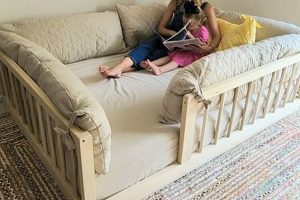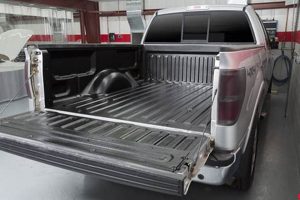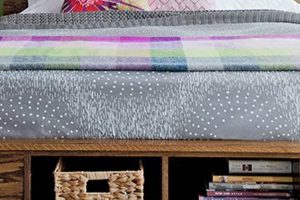Maintaining consistently snug bedding enhances sleep comfort and the overall aesthetic of a bedroom. Several methods, often involving common household items or readily available accessories, can achieve this desired tightness without professional assistance. One example involves using elastic bands or straps to secure the sheet corners beneath the mattress, preventing slippage and wrinkles.
This proactive approach to bed sheet maintenance offers numerous benefits. Beyond enhanced comfort, it contributes to a tidier, more visually appealing sleep environment. The practice also minimizes sheet wear and tear by reducing friction caused by movement during sleep. Historically, securing bedding has been a concern addressed through various techniques, evolving from simple pinning methods to the sophisticated elasticized designs of modern fitted sheets.
The following sections detail various cost-effective and straightforward approaches to keep sheets firmly in place, addressing different bed sizes, sheet types, and individual preferences. These techniques aim to provide practical solutions for achieving and maintaining a taut and comfortable sleeping surface.
Practical Techniques for Sustaining Snug Bedding
The following presents methods designed to minimize sheet slippage and maintain a neat, taut bed arrangement. These techniques primarily utilize readily available materials and require minimal specialized skills.
Tip 1: Employing Bed Sheet Fasteners: Commercial bed sheet fasteners, typically consisting of elastic straps with clips, attach to the sheet corners and secure them under the mattress. This method applies consistent tension, preventing the sheet from loosening overnight.
Tip 2: Utilizing Elastic Bands: Heavy-duty elastic bands, similar to oversized rubber bands, can be wrapped around the mattress corners to hold the fitted sheet edges in place. Ensure bands are appropriately sized to avoid excessive stretching or slippage.
Tip 3: Securing with Safety Pins: Heavy-duty safety pins can be used discreetly to attach the fitted sheet to the mattress cover or bottom sheet. Exercise caution to avoid injury when handling safety pins, and regularly inspect them for signs of wear or loosening.
Tip 4: Repurposing Pant Suspenders: Pant suspenders can be clipped to the sheet corners and stretched beneath the mattress to create tension. Choose suspenders with sturdy clips to ensure a secure hold.
Tip 5: Creating DIY Corner Straps: Fabric scraps and elastic can be sewn together to create custom corner straps. These straps can be tailored to the specific dimensions of the mattress and sheets, providing a personalized securing solution.
Tip 6: Mattress Grippers or Non-Slip Pads: Placing non-slip pads or mattress grippers between the mattress and the box spring can prevent the entire bed from shifting, which indirectly helps maintain sheet tightness. This method is especially effective for beds on smooth or hard floors.
Tip 7: Fitted Sheet Modifications: For sheets that are consistently too loose, consider altering the elastic band within the fitted sheet. Replacing or tightening the elastic can provide a more snug fit.
Implementing these techniques can result in a more comfortable and aesthetically pleasing sleeping environment. Consistent application of these methods minimizes sheet movement and associated discomfort.
The subsequent sections will delve into selecting appropriate materials and troubleshooting common challenges encountered when implementing these methods.
1. Sheet Fastener Quality
The effectiveness of techniques aimed at maintaining taut bedding is directly correlated with the quality of the sheet fasteners employed. These fasteners serve as the primary mechanism for securing the sheets to the mattress, and their durability and design dictate the longevity and stability of the system. Compromised fastener quality negates the intended benefits, rendering efforts to maintain a snug fit ineffective.
- Material Durability
Fasteners constructed from low-grade materials, such as inexpensive plastics or thin elastic, are prone to breakage or stretching under tension. This failure results in sheets detaching from the mattress, requiring frequent adjustments or replacements. High-quality fasteners utilize durable materials like reinforced nylon, robust metal clips, and thick, resilient elastic, thereby withstanding repeated use and sustained tension.
- Clip Mechanism Strength
The clip mechanism of a sheet fastener determines its ability to grip the sheet fabric securely without causing damage. Weak or poorly designed clips slip easily or tear the fabric, rendering the fastener ineffective. Superior fasteners employ clips with a strong, reliable grip and a smooth contact surface to minimize fabric wear. Examples include metal clips with protective rubber or plastic coatings or adjustable-tension gripping mechanisms.
- Adjustability and Tension Control
Effective sheet fasteners allow for adjustable tension, accommodating various mattress thicknesses and sheet sizes. Fasteners with limited adjustability may be either too loose, failing to provide adequate tension, or too tight, potentially damaging the sheets or mattress. High-quality fasteners offer a range of tension settings, allowing for a customized fit that maximizes sheet tautness without compromising the integrity of the materials.
- Design and Construction
The overall design and construction of sheet fasteners influence their ease of use and effectiveness. Bulky or poorly designed fasteners can be difficult to install or interfere with sleep comfort. Streamlined designs that minimize bulk and utilize intuitive attachment mechanisms enhance user experience and ensure consistent performance. Examples include fasteners with cross-corner designs for even tension distribution or fasteners with quick-release mechanisms for easy sheet removal.
The inherent properties of sheet fasteners, particularly their material durability, clip mechanism strength, adjustability, and overall design, collectively determine their contribution to maintaining consistently snug bedding. Investing in high-quality fasteners represents a critical component of achieving a tidy and comfortable sleeping environment.
2. Elastic Band Strength
Elastic band strength is a critical determinant in the effectiveness of methods employed to secure bedding. The ability of an elastic band to maintain tension directly influences the tautness of the fitted sheet, and its failure to provide adequate force results in slippage and wrinkles. Therefore, understanding the factors contributing to elastic band strength and its degradation is essential for achieving consistently snug bed linens.
- Material Composition and Elasticity
The composition of the elastic material dictates its inherent strength and elasticity. Natural rubber elastics offer superior stretch and recovery compared to synthetic alternatives like polyurethane. However, natural rubber degrades more rapidly under exposure to heat and sunlight. The optimal choice balances elasticity with resistance to environmental degradation to ensure prolonged performance in bedding applications. For instance, a blend of natural and synthetic rubber may provide a compromise between elasticity and durability.
- Band Width and Thickness
Band dimensions influence load-bearing capacity. Wider and thicker bands distribute force more evenly and are less prone to stretching or snapping under tension. Thin bands concentrate stress, leading to premature failure. For bedding applications, selecting bands with appropriate width and thickness based on the size and weight of the mattress is critical. A wider band provides a larger contact area, reducing stress on individual fibers and extending the band’s lifespan.
- Resistance to Degradation
Elastic bands are susceptible to degradation from exposure to heat, light, and chemicals. Frequent washing and drying cycles can accelerate this process, reducing elasticity and ultimately leading to band failure. Selecting bands treated with UV protectants or utilizing washing techniques that minimize exposure to high temperatures can extend the lifespan. For example, air-drying bands instead of using a high-heat dryer setting preserves their elasticity.
- Attachment Method Security
The manner in which the elastic band is attached to the sheet or fastener directly impacts its effectiveness. Weak or poorly secured attachments result in band detachment, rendering the system useless. Reinforced stitching, secure clips, or integrated designs that distribute stress evenly across the band’s attachment points enhance longevity and prevent premature failure. A well-sewn seam with multiple rows of stitching provides a more secure attachment compared to a single, weak stitch.
In summary, the success of maintaining taut bedding using elastic bands hinges on the careful selection of materials, appropriate band dimensions, resistance to environmental degradation, and secure attachment methods. A holistic approach that considers these factors ensures that elastic bands effectively contribute to a comfortable and aesthetically pleasing sleeping environment.
3. Pin Placement Security
The effectiveness of securing bedding utilizing pins depends heavily on the precision and strategic nature of pin placement. Improper or inadequate placement undermines the entire process, negating the intended benefits of achieving taut and wrinkle-free bed linens. Pin placement directly influences the distribution of tension across the sheet, impacting its ability to remain firmly anchored to the mattress. A single poorly positioned pin can act as a weak point, leading to localized stress and eventual detachment, thus compromising overall sheet security.
Consider the common scenario where pins are positioned too close to the edge of the sheet. The limited fabric margin in this arrangement increases the likelihood of tearing or slippage, particularly under the forces generated by movement during sleep. Conversely, placing pins too far from the edge might create unsightly folds or leave portions of the sheet inadequately secured, resulting in uneven tension and diminished aesthetic appeal. Effective pin placement involves identifying areas where the sheet is most prone to slipping or bunching, concentrating pinning efforts in those regions while maintaining an even distribution of force. An example includes reinforcing corners, which experience significant stress due to the mattress shape, with multiple strategically placed pins.
Optimal pin placement ensures both security and concealment. Pins should be positioned in areas where they are unlikely to be felt or seen, minimizing discomfort and preserving the bed’s visual appearance. Furthermore, consistent monitoring of pin integrity is crucial. Pins that become bent, loose, or detached pose both a safety hazard and a threat to sheet security. Therefore, regular inspection and replacement of compromised pins are essential to maintaining the integrity of the bed linen arrangement. In conclusion, strategic pin placement, coupled with ongoing maintenance, is a critical component in successfully implementing pinning methods for sustained sheet tautness.
4. Fabric Friction Reduction
The efficacy of maintaining taut bed sheets is significantly influenced by the degree of friction between the sheets and the underlying mattress or bedding materials. High friction impedes sheet movement and contributes to wrinkling, bunching, and eventual loosening, thereby directly undermining efforts to keep sheets tightly fitted. Conversely, reducing friction facilitates smoother sheet movement, allowing techniques employed to secure the sheets to function more effectively. A practical example is the use of a non-slip mattress pad, which increases friction between the mattress and the bed frame, indirectly contributing to sheet tautness by minimizing overall mattress movement.
Implementing strategies to lower friction involves selecting appropriate materials and applying specific techniques. Sheets made of tightly woven, smooth fabrics, such as high-thread-count cotton or microfiber, exhibit inherently lower friction coefficients than coarser materials. Furthermore, the application of fabric softeners during laundering, while potentially impacting breathability, can temporarily reduce surface friction. However, the strategic placement of friction-reducing materials is often more effective. A thin layer of silk or satin placed between the fitted sheet and the mattress can significantly decrease resistance, allowing the sheet to adjust more readily to movement without losing its tautness. Additionally, ensuring that the fitted sheet is correctly sized for the mattress prevents excessive stretching and bunching, further minimizing friction-related issues.
In summary, minimizing friction between bed sheets and the mattress is a crucial component of maintaining tight bedding. Selecting smooth, high-quality materials, considering the strategic use of friction-reducing layers, and ensuring correct sheet sizing all contribute to a more stable and comfortable sleep environment. While challenges exist in balancing friction reduction with other desirable sheet properties like breathability and durability, the practical benefits of reducing friction in sustaining sheet tautness are substantial and directly impact the overall effectiveness of DIY sheet-securing methods.
5. Mattress Grip Enhancement
Mattress grip enhancement plays a critical, albeit often overlooked, role in the success of do-it-yourself methods designed to maintain taut bedding. The stability of the mattress directly influences the propensity of sheets to slip, bunch, and ultimately lose their intended fit. A mattress that shifts readily necessitates more frequent sheet adjustments and diminishes the effectiveness of other sheet-securing techniques.
- Non-Slip Mattress Pads
Non-slip pads, typically constructed from rubber or textured polymers, are positioned between the mattress and the bed frame or foundation. These pads increase the coefficient of friction, preventing the mattress from sliding, particularly on smooth surfaces such as metal or wooden bed frames. The increased mattress stability translates to reduced strain on sheet fasteners and a more consistently taut bed arrangement. For example, a latex mattress on a metal platform bed benefits significantly from a non-slip pad.
- Velcro Strips or Grippers
Strategically placed Velcro strips or adhesive grippers can be affixed to both the mattress and the bed frame to create a more secure connection. These fasteners provide a localized grip that resists lateral movement. The placement is crucial; concentrating these strips at the corners of the mattress offers maximum resistance to the forces that typically cause shifting. This method is particularly effective for preventing mattresses from sliding off adjustable bed frames.
- Fitted Mattress Encasements
A fitted mattress encasement, especially one constructed from a slightly textured material, provides an additional layer of grip. The snug fit of the encasement minimizes internal mattress movement, while the textured surface increases friction against the bed frame. This approach offers the added benefit of protecting the mattress from dust mites and allergens, promoting a healthier sleep environment. Encasements are a comprehensive solution, addressing both mattress stability and hygiene.
- Weight Distribution Techniques
While not directly related to grip enhancement materials, optimizing weight distribution on the bed can indirectly improve mattress stability. Uneven weight distribution contributes to localized pressure points, which can exacerbate mattress shifting. Ensuring that the bed frame is properly supported and that weight is evenly distributed across the mattress surface minimizes these pressure points, thereby enhancing overall stability and contributing to more effective sheet retention. Regularly rotating the mattress is a practical example of this technique.
In conclusion, enhancing mattress grip through the utilization of non-slip pads, Velcro strips, fitted encasements, and strategic weight distribution significantly complements DIY efforts to maintain tight bed sheets. These methods collectively contribute to a more stable sleep environment, reducing the frequency of sheet adjustments and maximizing the effectiveness of other sheet-securing techniques. Addressing mattress stability is, therefore, a fundamental aspect of achieving consistently snug and aesthetically pleasing bedding.
6. Sheet Elastic Replacement
Sheet elastic replacement is a direct and frequently necessary intervention within the scope of maintaining taut bedding. Deteriorated elastic in fitted sheets represents a primary cause of sheet slippage and loosening, directly counteracting efforts to achieve a consistently snug bed arrangement. This process restores the functionality of the fitted sheet, enabling it to effectively grip the mattress and resist movement.
- Identification of Elastic Degradation
The initial step involves accurately identifying when elastic replacement becomes necessary. Indicators include visible stretching, loss of elasticity (where the band no longer returns to its original length after being stretched), or complete breakage of the elastic. Subtle cues include sheets that consistently loosen despite other securing methods. Replacing elastic prematurely is unnecessary, while delaying the procedure compromises bedding tautness. For instance, a fitted sheet that requires constant re-tucking despite using sheet straps likely requires elastic replacement.
- Selection of Appropriate Elastic
The choice of replacement elastic directly impacts the outcome of the repair. Factors to consider include the elastic’s width, thickness, and material composition. Wider elastics distribute tension more evenly, while thicker elastics offer greater resistance to stretching. Material options range from braided to knitted elastics, each with varying degrees of stretch and durability. Using an elastic with inferior stretch resistance, such as a thin, inexpensive braided elastic, would result in premature failure and necessitate repeated replacements.
- Proper Removal of Old Elastic
The removal of degraded elastic requires careful execution to avoid damaging the surrounding sheet fabric. Cutting the old elastic at several points and gently pulling it out of its casing is recommended. Avoid tearing or stretching the fabric, as this can weaken the seams and create entry points for future wear and tear. Improper removal, such as ripping the elastic out forcefully, can irreparably damage the sheet, rendering it unusable.
- Secure Attachment of New Elastic
The new elastic must be securely attached to the sheet to prevent slippage and ensure long-term durability. Techniques include sewing the elastic directly to the fabric casing using a zigzag stitch or employing specialized elastic fasteners. Overlapping the ends of the elastic and securely stitching them together creates a continuous, reinforced loop. Insufficient stitching or the use of weak thread can result in the elastic detaching from the sheet during use, negating the benefits of the replacement.
Addressing sheet elastic degradation through diligent replacement directly contributes to achieving consistently snug bedding. By properly identifying the need for replacement, selecting appropriate materials, and employing secure attachment techniques, individuals can effectively maintain the tautness and functionality of their fitted sheets, supporting the overall goal of ensuring comfortable and aesthetically pleasing bedding arrangements.
Frequently Asked Questions
The following addresses common inquiries regarding practical approaches to maintain taut bedding, providing clarity on various techniques and related considerations.
Question 1: Is it necessary to purchase specialized products to keep bed sheets tight?
The necessity depends on individual preferences and the severity of sheet slippage. Readily available household items, such as elastic bands and safety pins, can prove effective for minor adjustments. However, commercial sheet fasteners often provide a more durable and reliable solution, particularly for restless sleepers or individuals seeking long-term stability.
Question 2: How frequently should sheet fasteners be adjusted?
Adjustment frequency varies based on fastener type, sheet material, and sleeping habits. Regular inspection, ideally during sheet changes, allows for prompt re-tightening of fasteners that have loosened. Some higher-quality fasteners may require minimal adjustments over extended periods, while others may necessitate weekly attention.
Question 3: Can pinning methods damage bed sheets?
Improper pinning techniques pose a risk of fabric damage. Using heavy-duty safety pins, positioning pins strategically within seams or reinforced areas, and regularly inspecting pins for sharpness are crucial precautions. Avoid pinning delicate fabrics or applying excessive force, which can lead to tearing.
Question 4: Are there specific sheet materials that inherently stay tighter than others?
Tightly woven fabrics, such as high-thread-count cotton or microfiber, generally exhibit greater resistance to slippage than looser weaves like jersey knit. Fitted sheets with deep pockets are also more likely to maintain a secure grip on thicker mattresses, reducing the strain on securing methods.
Question 5: How do mattress protectors influence sheet tightness?
Mattress protectors can either enhance or hinder sheet tightness. Textured protectors with a non-slip surface can provide additional grip, while smooth protectors may exacerbate slippage. Selecting a protector with appropriate grip and ensuring a snug fit are essential considerations.
Question 6: Can worn elastic in fitted sheets be repaired?
Worn elastic in fitted sheets can often be repaired by replacing the degraded elastic band. This involves carefully removing the old elastic and sewing a new band into the existing casing. This process restores the sheet’s original fit and reduces the need for alternative securing methods.
These frequently asked questions highlight practical considerations for individuals seeking to maintain consistently taut bedding. Implementing these insights contributes to a more comfortable and aesthetically pleasing sleep environment.
The subsequent section will present a concise summary of effective approaches and best practices discussed within this article.
In Conclusion
This exploration of how to keep bed sheets tight diy has presented numerous practical methods for achieving and maintaining snug bedding. From employing commercial sheet fasteners to repurposing common household items, the discussed techniques offer cost-effective solutions to address sheet slippage and ensure a more comfortable sleep environment. Emphasis has been placed on factors such as material selection, proper implementation, and ongoing maintenance to maximize the effectiveness of chosen methods.
The successful application of these approaches relies on a commitment to detail and a willingness to adapt techniques to individual bedding configurations. While achieving consistently taut bedding may require some experimentation, the enhanced comfort and improved aesthetic contribute significantly to the overall sleep experience. The principles outlined herein offer a foundation for ongoing refinement and personalized solutions, ultimately leading to a more restful and visually appealing sleep space. Therefore, continued attention to these details proves essential for sustained bedding satisfaction.







